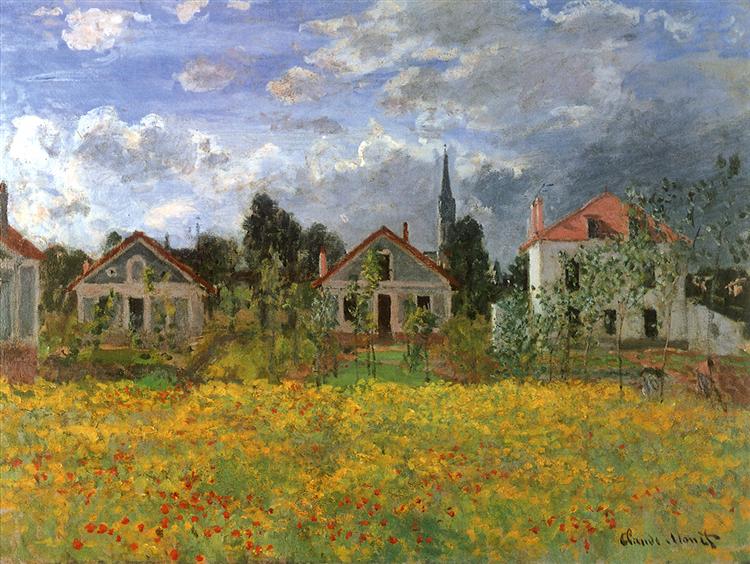Description
Claude Monet's Houses at Argenteuil (1873) is a paradigmatic example of the painter's transition to the techniques that would define the Impressionist movement. Depicting the tranquility of a day in the town of Argenteuil, near Paris, this painting captures a scene that, although mundane, is transformed into something extraordinary through Monet's singular eye. The composition is dominated by softly colored houses, arranged in a way that establishes a harmonious connection with the surrounding landscape. The horizontal and vertical lines that form the buildings contrast subtly with the fluidity of natural elements, such as the sky and the trees.
Monet uses a colour palette that reflects his interest in light and its effects on the environment. Shades of blue are combined with bright greens and touches of white, possibly representing the clouds and sunlight playing on the water of the river that runs through Argenteuil. This colour choice not only adds depth to the scene, but also underlines the serene and welcoming atmosphere that prevails in the work. The colours are not applied evenly; instead, Monet opts for thick brushstrokes that suggest movement and vitality, revealing his desire to capture the ephemeral and transitory nature.
In this painting, the absence of human figures may seem notable, a contrast to other works of his time that often included characters in the natural environment. However, this decision by Monet further highlights the tranquility and isolation. The serenity of the landscape seems to invite the viewer to reflect on the beauty inherent in everyday life; the work becomes a space into which the observer can project his or her own emotions and experiences. By not including figures, Monet allows elements such as the house, trees, and sky to be the protagonists of the visual narrative.
Monet's impressionist technique, in which visual results are achieved through the application of pure colors and their interaction, is visible in "Houses at Argenteuil." Here, the fusion of colors and variation in brushstrokes emphasize the vibrant atmosphere of the landscape at a specific moment. This technique contrasts with the more traditional academic methods of his time, which favored a more polished and detailed finish. Monet moves away from exact representation and instead focuses on the overall impression that light and color create on the observer.
Argenteuil was a recurring location in the work of Monet and other Impressionist painters, reflecting the 19th-century fascination with suburban areas that offered an escape from urban life. Monet's connection to this landscape is also personal, as he lived in Argenteuil for several years and its everyday surroundings inspired numerous works, helping to cement its place in the development of Impressionism.
In conclusion, “Houses at Argenteuil” is not just a depiction of a landscape; it is a meditation on light, color, and nature itself. Monet captures the essence of a moment, inviting the viewer to immerse themselves in the visual and emotional experience of art. This work stands out not only for its aesthetic beauty, but also for its bold rejection of the artistic conventions of the time, a true statement of the Impressionist spirit that would transform the art landscape. When looking at this work, we contemplate not only Monet’s technical mastery, but also his deep connection to the natural world around him, a legacy that continues to resonate strongly to this day.
KUADROS ©, a famous painting on your wall.
Hand-made oil painting reproductions, with the quality of professional artists and the distinctive seal of KUADROS ©.
Painting reproduction service with satisfaction guarantee. If you are not completely satisfied with the replica of your painting, we will refund 100% of your money.

